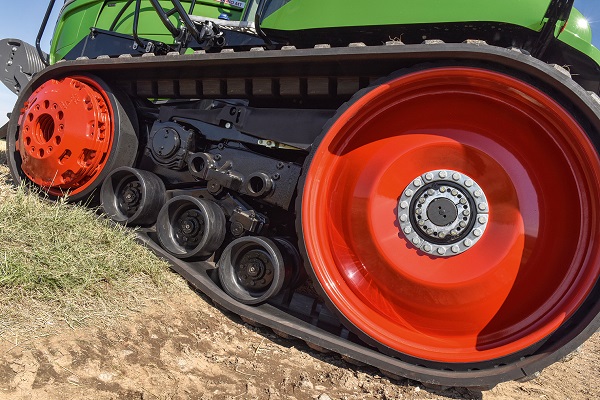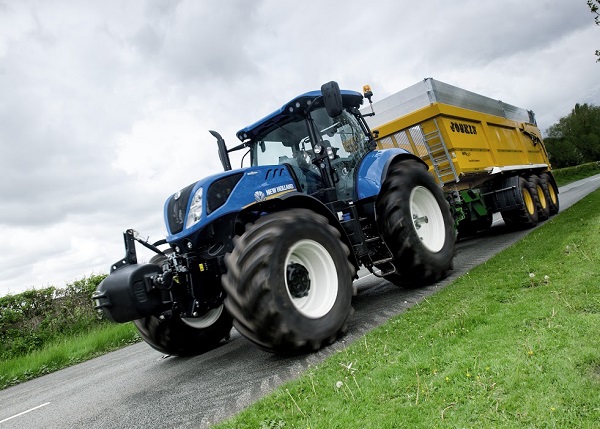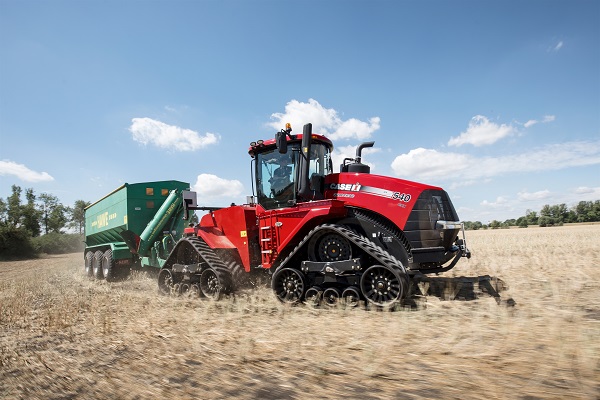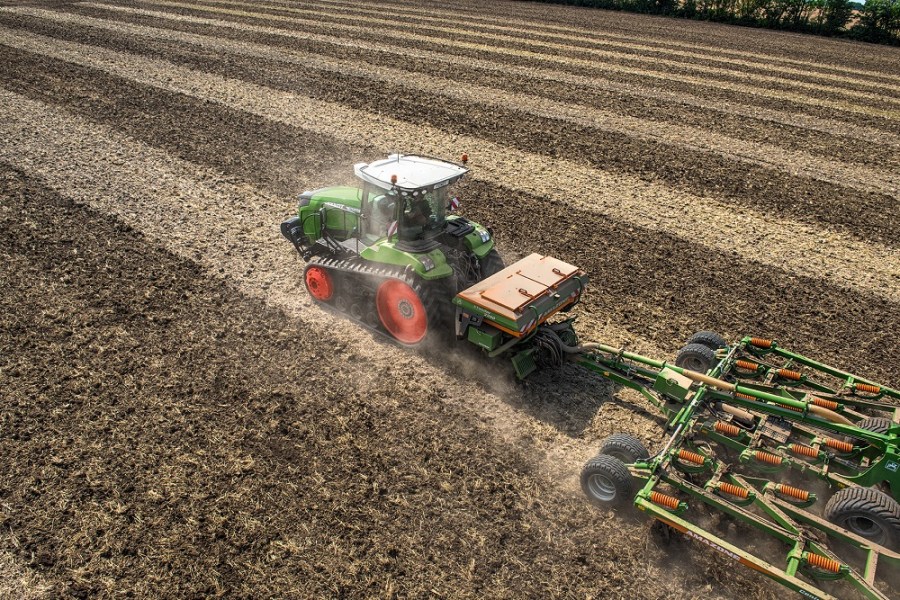Tractor manufacturers have been busy sprucing up their ranges, with some enticing offerings set to go on show next month. CPM takes a look at what’s new.
This is not just a paint job.
By David Jones
Size, horsepower, technology and control. Four of the key considerations influencing buyers of new tractors. And all to come under the spotlight, as the high point of the marketing year for most machinery manufacturers approaches.
Many of the industry’s design engineers have been busy this year – innovating, refining, enhancing and reinventing – in readiness for next month’s Agritechnica event in Hanover. Close to 3000 exhibitors will occupy 23 halls this year, so visitors will need to be well-prepared with lists of must-see destination stands.
Fendt on tracks
A fair few of those lists could include the new Fendt flagship tractor, the 900 Vario MT tracked machine, which has come into being as a result of AGCO’s decision not to market its Challenger brand in the Europe, Africa & Middle East region. This is not just a paint job, however.

The Fendt tracks are of the same design as the Challenger 700 MT ones they replace and are all suspended, but with no marshmallow element in the system.
The 900 Vario MT retains the engine of the Challenger 700 series and the CAT track differential steering, but the rest is new. There’s a new CVT transmission and a new suspended cab (from the Fendt 1000 Series wheeled tractor) which sits slightly further forward than on the Challenger 700 MT that it replaces.
The tracks are fundamentally of the same design – but slightly longer – and are all suspended, but with no marshmallow element in the system. Three power versions are available – the Fendt 938 Vario MT with 380hp, the 940 Vario MT – 405hp, and the Vario 943 MT at 431hp.
Those looking for more grunt may go for the Fendt 1100 MT. This comes in four performance classes: the Fendt 1149 MT with 492hp, 1154 MT with 536hp, 1159 MT with 592hp, and the 1165 MT tops the range with 646hp. The Fendt 1100 MT is identical to the big current Challenger tracked tractors, with four pendulum suspension middle track rollers and quick-shift gear.
Somewhat lower down the power scale, Fendt will also be launching the 200 Vario and a 200 Vario V/F/P version. This is a range of high output compact tractors designed for working in orchards, hop fields and vineyards. Powered by three-cylinder 70hp to 110hp engines, the 200 Vario will include a pre-installed guidance system, with accuracy +/- 2cm, even, Fendt says, in adverse weather conditions.
New Holland upgrades
This year’s offering from NH involves some significant upgrading of its T7 LWB series. The four models in the 180hp-240hp range now have a new suspended front axle and steering control to provide enhanced precision at higher speeds, while the TerraGlide front suspension has been uprated for improved stability and operator comfort.

The four models in the 180hp-240hp range now have a new suspended front axle and steering control, while the TerraGlide front suspension has been uprated.
To boost performance over a wide variation of front axle loads, a new control valve with dual accumulators has been fitted, which has the effect of reducing chassis vibration when the tractor is hitched to a heavy rear implement. The suspension concept is known as Skyhook, commonly used in sports cars, the function of which is to maintain the tractor on a level bearing when, for example, an implement is being raised or lowered.
Vehicle manoeuvrability now benefits from the new CustomSteer variable ratio steering. This allows the operator to vary the number of rotations of the steering wheel it requires to turn the axle hubs from lock to lock, with a choice three selectable settings.
Higher payloads – now up to 14,000kg – are now possible on the NH T7 series following an upgrade, while in the cab, new instrumentation provides the operator with greater clarity of information.
Full-track CVT
Case IH marks its 175th anniversary by introducing the first full-track CVT articulated tractor. The new CVXDrive transmission option, available on its mid-range Quadtrac models 470, 500 and 540, is claimed to provide a boost to operating efficiency and productivity.

The system has been designed to provide stepless forward progress from 0-43km/h and 0-17km/h in reverse.
Ease of use – for inexperienced operators, in particular – merges with faster acceleration in field and on road, full power availability and hydraulic flow at low ground speeds. Reduced operator fatigue is another claimed benefit. A feature of the control systems is Automatic Productivity Management (APC) which has been designed to ensure the machine is operating at optimum efficiency – whether the target is maximum output or minimum fuel consumption.
This system has been designed to provide stepless forward progress from 0-43km/h and 0-17km/h in reverse, with the CVX permitting storage of three adjustable speeds within that bracket. This is set and adjusted using a thumbwheel on the Multicontroller, while the transmission also has a kick-down feature for when maximum acceleration is needed.
Another new feature is Active Hold Control which, when the machine is brought to a halt on a slope, can remain static without the operator having to apply his foot or the hand brake. If the tractor remains in this state for longer than 45 seconds, the parking brake is applied automatically.
For its wheeled Maxxum tractors, Case will be introducing the option of a new semi-powershift transmission with eight steps in each of its three ranges– the ActiveDrive 8 – to be offered as an alternative to the existing four-speed spec.
In addition, the number of models in the Maxxum range goes up by one, with the launch of the new, range-topping, 175hp (max) six-cylinder 150 CVX. With this model, Case claims the lightest, smallest tractor in the industry from a six-cylinder engine of this power output.
Enhanced comfort for operators should result from an upgrade on the Puma 185 Multicontroller to Puma 240 CVX tractors, which will be provided by ‘significant front axle suspension improvements’ and be particularly noticeable as axle loads alter.
The revisions are designed to improve the speed of response of the suspension system and the degree of cushioning it provides, both in field and in transport. Meanwhile, gross vehicle weight allowances have also been raised by 650kg on Puma Multicontroller models and 1000kg on Puma CVX tractors.
Claas steps up
A new generation of Arion 600 and 500 tractors is being hailed by Claas ahead of Agritechnica, with a wider choice of equipment options and engines, together with a range of new features. These include the new CIS+ system, the CEBIS terminal, updated Hexashift and Cmatic transmission functions, together with the newly-developed Proactiv front axle suspension.
Power output of the Arion series has been broadened at each end of the range and now, in relation to the Arion 510, stretches between 125hp and 185hp (205hp in the case of the Arion 660), with Claas Power Management (CPM) boosting the output by up to 20hp for transport and PTO operation.
At the top end of the Claas tractor line-up, the Axion 900 series gets a power boost and a number of new features. While retaining the six-cylinder FPT Cursor 8.7-litre engine, there is now a variable geometry turbo as standard. This creates optimum charge-air pressure, according to load and engine speed.
By doing this, Claas explains, 70% of maximum torque is available, even when idling. Maximum engine output in the Axion 920 to 960 models now spans the 325hp to 425hp range.
More torque at lower speeds was another challenge for the engineers at Claas – one to which they responded with an 18% torque boost. At the same time, this is achieved at up to 200rpm lower engine speed, so reducing fuel consumption. For good measure, an extra 2 l/hr of diesel are saved by automatically reducing the idling speed from 800 to 650 rpm when the tractor’s stationary.
In Eco PTO mode, as much as 95% of maximum engine output is diverted to the PTO shaft, despite the reduced engine speed, which, in turn, allows heavy implements to be employed at a lower speed.
New MF 5700 models
Over the period that AGCO has been overseeing the metamorphosis of Challenger, Massey Ferguson has been typically active in the area of new developments for its own range of tractors.
Two new models have been added to MF’s 5700 Global tractor series with the introduction of the MF 5708 and 5709, each with 3.3-litre three cylinders, providing 85hp and 95hp respectively, Dyna-4 transmissions and with the options of cab suspension and Visio Roof. These are all-rounders, the company says – ideal for long hours spent in field or yard.
The wraps will also be coming off a new range of vineyard/orchard tractors – the MF 3700 – with four models in the 75hp to 105hp bracket. In addition, there will be a WF – Wide Fruit – model. As its description suggests, the WF is a wider machine for orchard use, providing a lower centre of gravity and more stability on sloping terrain. Wider axles and a more spacious cab could see this model also being put to work on hillside vineyards or in livestock operations.
New features include more powerful hydraulic flow, a factory-fitted loader subframe, front PTO and linkage, four wheel-drive sensor and transmission controls on the gear lever and joystick. At the same time, the service interval has been extended to 600 hours.
Over the period that AGCO has been overseeing the metamorphosis of Challenger, Massey Ferguson has been typically active in the area of new developments for its own range of tractors.
Two new models have been added to MF’s 5700 Global tractor series with the introduction of the MF 5708 and 5709, each with 3.3-litre three cylinders, providing 85hp and 95hp respectively, Dyna-4 transmissions and with the options of cab suspension and Visio Roof. These are all-rounders, the company says – ideal for long hours spent in field or yard.
The wraps will also be coming off a new range of vineyard/orchard tractors – the MF 3700 – with four models in the 75hp to 105hp bracket. In addition, there will be a WF – Wide Fruit – model. As its description suggests, the WF is a wider machine for orchard use, providing a lower centre of gravity and more stability on sloping terrain. Wider axles and a more spacious cab could see this model also being put to work on hillside vineyards or in livestock operations.
New features include more powerful hydraulic flow, a factory-fitted loader subframe, front PTO and linkage, four wheel-drive sensor and transmission controls on the gear lever and joystick. At the same time, the service interval has been extended to 600 hours.
Over the period that AGCO has been overseeing the metamorphosis of Challenger, Massey Ferguson has been typically active in the area of new developments for its own range of tractors.
Two new models have been added to MF’s 5700 Global tractor series with the introduction of the MF 5708 and 5709, each with 3.3-litre three cylinders, providing 85hp and 95hp respectively, Dyna-4 transmissions and with the options of cab suspension and Visio Roof. These are all-rounders, the company says – ideal for long hours spent in field or yard.
The wraps will also be coming off a new range of vineyard/orchard tractors – the MF 3700 – with four models in the 75hp to 105hp bracket. In addition, there will be a WF – Wide Fruit – model. As its description suggests, the WF is a wider machine for orchard use, providing a lower centre of gravity and more stability on sloping terrain. Wider axles and a more spacious cab could see this model also being put to work on hillside vineyards or in livestock operations.
New features include more powerful hydraulic flow, a factory-fitted loader subframe, front PTO and linkage, four wheel-drive sensor and transmission controls on the gear lever and joystick. At the same time, the service interval has been extended to 600 hours.
John Deere comfort boost
Already claimed to be Europe’s best-selling tractors, John Deere’s 5M Series has been upgraded in the comfort and performance departments. Popular with mixed and livestock farmers, the four-model range occupies the 75hp to 115hp power bracket, the three larger machines having four cylinders, the 75hp, three.
With regard to the 5M Series cab, there are four options: open station, standard, premium and narrow. Enhancements here include an improved interior finish, more storage, an air suspended seat, new digital display and a re-designed gear lever with new de-clutch function. Outside, these re-styled models can now be specified with larger 540/65R38 tyres, although the turning radius remains at 4m, while forward visibility has been improved by lowering the bonnet profile.
With rear-hitch capacity boosted to 4.32t and payload to 7.5t, the tractors can be equipped with new JD 543R or 603R front loaders, with a loader-ready option allowing for the necessary components to be fitted ex-factory.
Moving to the 5E Series 3-cylinder tractors – the 5058E, 5067E and 5075E – these have been re-designed to provide greater operator comfort and fitted with 2.9-litre Stage IIIB engines, generating 60-75hp. A choice of transmission options includes a new 24/12 PowerReverser transmission, enabling a top speed of 49km/h.
In the cab, a new right-hand control, together with the standard EQRL (electric quick raise & lower) hitch system simplifies implement operations. Additional features include electro-hydraulic activation of the PTO and hand throttle, while the new digital instrument panel provides better monitoring of the tractor’s main functions.
Also gracing the John Deere stand at Agritechnica – although already available this year – will be the manufacturer’s new flagship, the range-topping 400hp 8400R. This tractor has 6% more pulling power, compared with its predecessor, the 8370R, allowing wider implements to be employed in the field – at the same time as reducing fuel consumption.
In addition to these updates, the company’s 7R, 8R and 9R tractors are due to benefit from improved connectivity and integration into JD’s FarmSight range of precision farming solutions. The newly designed StarFire 6000 satellite receiver is now said to deliver better SF1 signal accuracy – from 23cm down to 15cm, with 3cm path-to-path accuracy. To this is now added in-season repeatability, speedier signal acquisition and a one-year subscription. And, there’s now an updated RTK and mobile RTK option, together with an optional new locking device for better theft protection.
Valtra advantage
Although Valtra’s latest ‘A’ Series smaller-to-medium-sized tractor range was unveiled earlier this year, it’s set to be a prominent feature of the Finnish manufacturer’s presence at Agritechnica.
Seven models span the 76hp to 130hp bracket, powered by 3- or 4-cylinder engines and fitted with a new common rail diesel injection system. On each version, the engine is mounted on a newly-configured front frame that allows the exhaust cleaning system and, indeed, the engine, not to compromise the operator’s lines of vision. New 12 + 12 transmissions and a re-designed cab complete the headline changes.
Aware of the likelihood that a relatively high proportion of ‘A’ Series models will be ordered with a factory-fitted front loader, Valtra has developed a number of bespoke versions to fit each model and specification. This has resulted in a range of re-modelled loader beam and tool carrier designs to facilitate clearer visibility for the operator and afford greater machine stability.
Deutz-Fahr under wraps
The company’s head of marketing, Graham Barnwell, confirms that a new machine is due to make its debut at the event, but that staff have been asked not to discuss details publicly beforehand.
And, finally, while JCB’s presence at Agritechnica will be substantial – principally in the shape of its Fastrac range – the company says that it doesn’t have any specific new developments to reveal this year, following the high profile launch of its 8000 Series in 2016.
Stage V emissions targets smaller engines
Time limits of 2019 and 2020 have been announced for the introduction of the latest phase of emissions standards – Stage V – in a continuation of the drive by the EU to reduce particulate and NOx emissions from non-road diesel engines.
Described as an evolution of the legislation that has gone before, applying to machines such as tractors, wheeled loaders and excavators, Stage V seeks to include the number as well as the volume of particulates produced.
This, according to engine manufacturer Perkins, is likely to require the wider use of diesel particulate filters (DPFs). For smaller, mobile engines in the 19-37kW (approximately 25-50hp) range there will be a particular impact, which will see the use of common rail fuel systems and exhaust after-treatments for the first time.
However, it’s expected that for most Original Equipment Manufacturers (OEMs), adapting their machines to meet the requirements of Stage V will demand a lower level of change than with previous emissions stages.
Oliver Lythgoe, the company’s product concept marketing manager, believes managing this extension of the legislation should be relatively straightforward, making use of the technology that’s already available. “The development of engines over the past 15 years has been dominated by the requirement to abide by emissions legislation,” he states.
“We see this as a time when we, as engine suppliers can work with OEMs to deliver more productive, better value machines. This is illustrated by the increases in power and torque that are already being incorporated in many of our engines.”
Manufacturers are not to be allowed any leeway during the implementation of Stage V emission standards. OEMs will have 18 months in which to run down stocks of engines built to previous standards and an additional six months in which to market and sell them.
So, how is this new legislative level likely to impact on farmers in the UK? Andy Curtis, Perkins sales manager to the agricultural sector, believes it depends how far along the lower emissions time-line each individual business has progressed so far.
“For those still operating equipment that’s pre-Stage IIIA, before the introduction of after-treatments, the change will be greater,” he says. “One of the targets we at Perkins have achieved is to introduce the changes in emissions legislation to our machines in a way that doesn’t impact on the operator.”
This has meant reducing overall consumption of fluids, while minimising downtime and lowering overall operating costs. Some applications within the agricultural sector are more familiar with the new technology. The combine harvester sector, for example, has already developed machines using this technology.
Where the changes will be felt more acutely, Andy believes, is on farms dependent on older, smaller wheeled tractors, where the gap that needs to be narrowed is currently greater.




